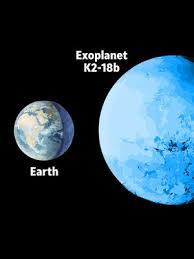Recent advancements in technology and a string of exciting discoveries have fueled speculation and optimism within the scientific community regarding the potential discovery of extraterrestrial life. Is humanity on the verge of definitively answering one of its most profound questions: Are we alone in the universe?
The K2-18b Discovery
A significant wave of excitement washed over the astrobiology community on April 17, 2025, with the announcement of potentially the "strongest evidence yet" of life beyond our solar system. Using the James Webb Space Telescope (JWST), scientists detected traces of dimethyl sulfide (DMS) and dimethyl disulfide (DMDS) in the atmosphere of exoplanet K2-18b. On Earth, these gases are exclusively produced by living organisms, primarily phytoplankton. K2-18b, located 124 light-years away in the constellation Leo, is a Hycean planet, meaning it is potentially an ocean world with a hydrogen-rich atmosphere.
While researchers emphasize that this is not a definitive discovery of life, the presence of these biosignature gases is a significant indicator of biological processes at play. Nikku Madhusudhan of the University of Cambridge's Institute of Astronomy hailed it as a "transformational moment in the search for life beyond the solar system," stating that the "only scenario that currently explains all the data obtained so far from JWST...is one where K2-18b is a hycean world teeming with life." However, other scientists urge caution, noting the possibility of unknown non-biological processes producing these gases.
Technological Advancements
The JWST is at the forefront of this revolution, with its ability to analyze the atmospheres of exoplanets in unprecedented detail. By observing the light that passes through a planet's atmosphere as it transits its star, scientists can identify the chemical composition, temperature, and pressure, searching for biosignatures like oxygen, methane, and now, DMS and DMDS. Future telescopes and interferometers, both ground-based and space-based, are expected to further refine these measurements, potentially allowing for the identification of more complex molecules indicative of life.
Beyond atmospheric analysis, scientists are also exploring other "technosignatures," or technological traces of intelligent life. These include radio or laser pulses, artificial chemicals in exoplanet atmospheres, and even megastructures like Dyson spheres built around stars to harness their energy.
The Search for Extraterrestrial Intelligence (SETI)
SETI programs are also evolving, incorporating new techniques and technologies to expand the search for intelligent signals. Commensal observing, where telescopes monitor for signals while conducting other astronomical observations, has significantly increased search sensitivity. Projects are also looking for narrowband signals broadcast over a small range of wavelengths, the kind of signals an intelligent civilization might intentionally transmit. The Square Kilometer Array (SKA), currently under construction in Western Australia and South Africa, promises to be the most powerful radio telescope ever built, poised to unlock some of the universe's most profound secrets and greatly enhance SETI efforts.
Challenges and Considerations
Despite the growing excitement, challenges remain. Defining "life" itself proves difficult, as we only have one example: life on Earth. Scientists must also carefully consider potential false positives, where non-biological processes mimic biosignatures. The distances involved are vast, and even with advanced technology, detecting faint signals from distant worlds is incredibly challenging.
Moreover, the search raises profound ethical and philosophical questions. What are the implications of discovering extraterrestrial life, both for humanity and for the potential life forms themselves? How would such a discovery impact our understanding of our place in the cosmos, our religions, and our societies?
Looking Ahead
The coming years promise to be an era of unprecedented discovery in the search for extraterrestrial life. As technology continues to advance and new missions come online, scientists will be able to probe exoplanet atmospheres with greater precision, search for a wider range of biosignatures and technosignatures, and explore new regions of our galaxy and beyond. While definitive proof of extraterrestrial life remains elusive, the recent findings and the rapid pace of technological innovation suggest that humanity may indeed be on the cusp of a profound and transformative discovery.

















